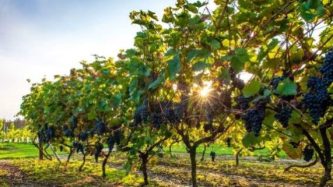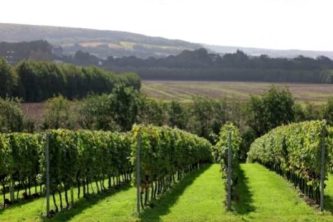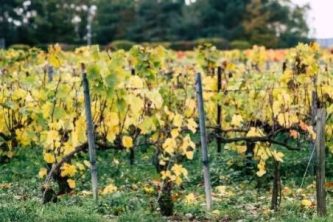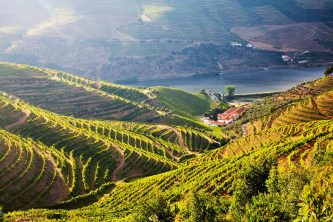Move over France … there’s a new kid on the European wine-making block and it might just be a little too close for comfort, writes Fiona Whitty, & explore
the Wine Garden of England.
 Believe it or not the United Kingdom is emerging as an exciting force in the wine-making industry, producing bottles that even the fussy French sometimes prefer.
Believe it or not the United Kingdom is emerging as an exciting force in the wine-making industry, producing bottles that even the fussy French sometimes prefer.
In a now-notorious taste test among Parisien restaurateurs three English sparkling wines were pitted against three elite Champagnes. The English challengers came out on top.
And last year the UK’s biggest wine producer, Chapel Down, headed to France’s Champagne region under the guise of the literally translated Chapelle en Bas to put their own fizz against a top local brand. The result? A staggering 60% preferred the English version.
Now in a further nod to the quality of English sparkling, French Champagne giant Taittinger has hopped across the Channel and snapped up land near London – recently producing their first-ever non-French fizz.
 There are some 700 vineyards dotted around England and Wales, blossoming thanks to warmer weather and, in some areas, chalky soil similar to that in the Champagne region.
There are some 700 vineyards dotted around England and Wales, blossoming thanks to warmer weather and, in some areas, chalky soil similar to that in the Champagne region.
And the county of Kent, southeast of London and where Domaine Evremond is based, is arguably the perfect place to start a wine discovery. It has more vineyards than anywhere else and garners a fantastic reputation, particularly for its sparkling.
Kent is dubbed the Garden of England thanks to its fantastic fruit growing. But viticulture fans could start by diving into the Wine Garden of England, a small band of esteemed vineyards that offer great experiences and fun events – and sometimes even top-class restaurants and accommodation.
We’ve etched out an itinerary below. As public transport in rural areas can be limited, hiring a car is best once you’ve caught a 55-minute train from London to Canterbury in the heart of Kent wine country. Companies generally offer automatics as well as manuals.
So, with the autumn harvest well under way, designate your driver and start popping open those Kent corks.
DAY ONE
 Once off the train, get a feel for beautiful Canterbury. Its magnificent cathedral and city walls are testament to its 1400-year-old history.
Once off the train, get a feel for beautiful Canterbury. Its magnificent cathedral and city walls are testament to its 1400-year-old history.
For your first tasting, swing by Corkk, a shop and wine bar where two-thirds of its stock is home-produced, much of it from Kent.
Enjoy a tutored wine flight, a glass of a wine of the week or a sample from its vending machine-style wine taster, which allows you to buy small measures from 10 different wines.
Staff will be delighted to guide you … they’re experts at Britain’s best specialist retailer, as nominated by viticulture bible Decanter.
Afterwards motor over to Simpsons Wine Estate for a vineyard tour followed by a tutored tasting.
It’s run by Ruth and Charles Simpson, who had already built up an award-winning vineyard in France when they spotted England’s potential and started up in Kent 12 years ago. Their Derringstone Pinot Meunier is deliciously crisp and fresh.
For some shut-eye head to the Pig at Bridge Place. The Pigs, a small but perfectly formed band of hotels, have become a national institution, revered for their character, warm service, sustainability and support for local produce.
This one doesn’t disappoint, with quirky lounges, roaring fires, wood panels, roll-top baths and antique furniture. Late afternoon cake hour with help-yourself homemade cakes and tours of their extensive kitchen garden are additional treats.
You’ll see the latter’s fruits in much of the restaurant’s menus, mostly sourced within a 40km radius – like its roasted squash starter and lemon sole with foraged sea buckthorn.
Its drinks menu reflects the same ethos; its own Piggy Fizz was made in nearby Sussex and there are over 30 other English wines available, many from Kent.
DAY TWO
Take a leisurely weave across the rolling Kent Downs countryside to Balfour Winery.
In 2007, their Brut Rose was the first ever English wine to win an International Wine Challenge gold.
Their new Winemakers’ Kitchen restaurant features dishes designed to complement their different wines, rather than the other way round.
Try pan-seared scallops in estate cider sauce served with Balfour’s Skye’s Chardonnay, followed by slow-roasted beef short rib with Luke’s Pinot Noir.
Save a bit of room and head over to Chapel Down, the UK’s biggest producer, for a tour followed by a tutored wine and cheese pairing, where you may discover how a creamy extra mature cheddar
suits the apple-freshness of the Kit’s Coty chardonnay.
In the shop, you can pick up a bottle of the Kit’s Coty Coeur de Cuvee 2016, recently named Supreme Champion – England’s best wine – at the WineGB awards.
Bed down at the Grape Escape, a cosy cottage based at another nearby vineyard, Biddenden – and watch the sunset over the vines from the wood-fired hot tub.
Kent’s chalky soil is similar to the Champagne region, making it ideal for producing sparkling wine.
DAY THREE
Stop off at the delightful Loddington Farm Shop – grab their Owlet juices made from fruit grown there – then enjoy lunch over at Bowleys at the Plough, a pub-cum-restaurant that dates to 1483.
Alongside a Kentish tasting menu try Bowleys’ own wine, made at the nearby Redhill Winery.
Afterwards, try one of the regular tastings at the Silverhand Estate, the UK’s largest organic vineyard where sheep graze between the vines to boost soil health and aid natural fertilisation and pest control.
For lights out try the Tickled Trout pub near Maidstone. Owned by Balfour Winery, the drinks menu includes several of its wines by the glass or bottle as well as tasting flights.
ON THE WAY BACK
Call in at Westwell, the Kent wine family’s quirky cousin. In autumn visitors can catch the odd supper club and – on most weeks – Pizza Fridays when a pizza van rolls up outside the fairy-light illuminated winery.
Don’t miss the Pinot Meunier Multi Vintage, a tongue-tingling fizz made without additives that recently bagged best innovative sparkling at the WineGB awards.
Make one last stop at the Tudor Peacock, a wine bar and shop in an old hall dating to the 14th century. Based in Chilham near the new Domaine Evremond winery, it offers samples of Kent’s finest plus talks and themed tastings in a stunning vaulted tasting room.


